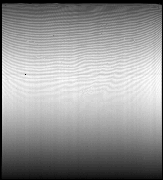Dome/Sky/Internal Flats - Spectroscopy
Contents
You find here a discussion of the different types of spectroscopic flats.
Spectroscopic Dome/Sky Flats
Spectroscopic Dome and Sky flats are defined using the same templates and observed in an identical manner; i.e. the telescope is not moved from one spectroscopic sky flat to another. The only difference is the purpose they serve : sky flats are used to determine the slit transfer function while dome flats are used to determine the pixel-to-pixel variation of the CCD gain.
One only needs to define the required number of counts in the template. The procedure takes a 1 second exposure and calculates the peak counts (after subtracting the bias and excluding pathological pixels). It then calculates the exposure necessary to achieve the required counts. If the required time is less than 1 second or more than 300 seconds the procedure returns an error and aborts the sequence.
Dome flats must be completed during the afternoon calibration session between 4.30 PM (local time) and sunset. The illumination source consists of an array of lamps of staggered brightness values. Different grism/binning/slit combinations require different settings of the lamps to achieve the required flat field level within a sensible amount of time (5 - 75 seconds). One can string together all the templates, with different grisms, slits and binning modes, in the same OB. However it would be more practical if one arranges the templates in an ascending (or descending) sequence of the required lamp brightness - a good indication of which being the grism dispersion.
Note that for most instrument set ups the required lamp and exposure time settings are already stored in a look up table, and so are completely automatic for the user. Only when using unusual combinations of optical elements, or asking for a level other than 40,000 counts will the times and lamp voltages have to be adjusted manually.
jP2PP Panel with Typical Parameters
The above example shows an OB comprising a sequence of:
- 5 Spectroscopic Dome Flat frames of 40,000 ADU peak counts with Grism #5 , Slit 1.5" , normal readout and 2x2 binning followed by
- 5 Spectroscopic Dome Flat frames of 40,000 ADU peak counts with Grism #1 , Slit 1.0" , normal readout and 2x2 binning
The FITS image output by the template is named EFOSC_FlatSpec.#.fits
As an example the following image is given, which shows a spectroscopic Dome Flat of 40,000 ADU peak counts with Grism #5, Slit 1.0", normal readout and 2x2 binning. Click on the image to get a larger version:
Parameter Values One does not have to (in fact, should not) change the value of any parameter other than :
- Starplate : same as Slit; see the complete Set of Slits available.
- Grism : See the complete Set of Grisms available.
- Intensity level : 40,000 ADU is both practical and sufficient. This level also ensure that even the brighter pixels on the CCD do not saturate.
- CCD readout speed : normal , fast or slow .
- CCD binning : 1x1 or 2x2.
- Number of exposures : 5 exposures are usually sufficient. 10 exposures may be necessary for very blue grisms
Spectroscopic Internal Flats
Internal Flats are only required when one wants to take flat frames while pointing to the target during the night. We have seen on a few occasions that grisms with heavy fringing in the red are not adequately defringed by the dome flats. This may be due to a combination of strong and narow fringing and CCD distortion with pointing. This effect is most obvious in Grism #12.
jP2PP Panel with Typical Parameters
The above example shows an OB comprising a sequence of
- 5 Spectroscopic Internal Quartz lamp Flat frames of 40,000 ADU peak counts with Grism #6 , MOS#1 slit plate , normal readout and 2x2 binning
The FITS image output by the template is named EFOSC_FlatIntSpec.#.fits
Parameter Values One does not have to (in fact, should not) change the value of any parameter other than :
- Starplate : same as Slit; see the complete Set of Slits available.
- Grism : See the complete Set of Grisms available.
- Intensity level : 40,000 ADU is both practical and sufficient. This level also ensure that even the brighter pixels on the CCD do not saturate.
- CCD readout speed : normal , fast or slow .
- CCD binning: 1x1 or 2x2.
- Number of exposures : 5 exposures are usually sufficient.
